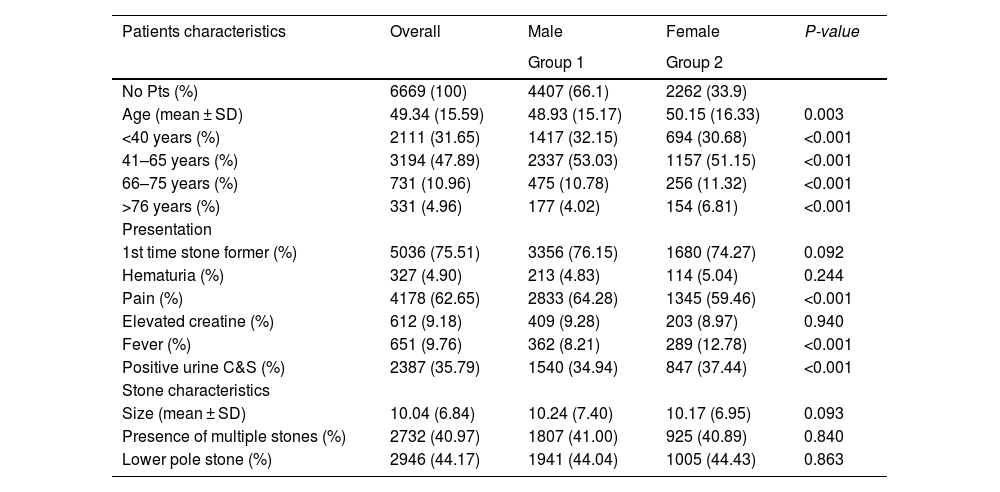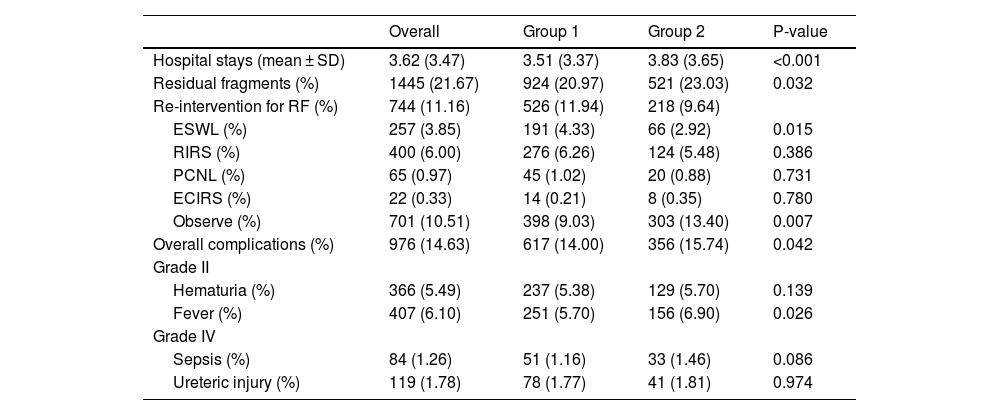As well established flexible ureteroscopy (RIRS). There is still no evidence if gender can have any influence on the outcomes and complication when performing. This study aims to evaluate the role that gender has in performing flexible ureteroscopy from a large series of patients.
MethodsThis study retrospectively analyzed patients who underwent RIRS for renal stones from January 2018 to August 2021 within the multicentric FLEXOR registry. Demographics, stone characteristics, perioperative findings, results and complications were analyzed and compared between gender groups.
ResultsA total of 6669 patients were included, 66.1% were male and 33.9% were female. Stone characteristics was comparable between groups. Female patients had significant higher fever and positive urine culture rates (12% vs. 8% and 37% vs. 34%). Also, females had a slight longer hospital stay (3.8 vs. 3.5 days; P < 0.001) and more residual fragments after the procedure (23.03% vs. 20.97 (P = 0.032). Overall complications were slightly significantly higher in women (15.74% vs. 14% (P = 0.042)) mainly at the expense of fever rates (6.9% vs. 5.7%) whereas the risk of sepsis was similar in both groups. A multivariate analysis showed that larger stone size, multiple and lower pole stones seem to have a negative impact in the incidence of residual stones and complications.
ConclusionOur real life global study reflects that female gender may have a correlation with a slightly increased residual fragment rate and overall low grade complications. However, women can safely be treated with RIRS with no increased the rate of sepsis with appropriate care.
Si bien la ureteroscopia flexible es una técnica establecida, a día de hoy no existen datos sobre la influencia del sexo del paciente en los resultados y complicaciones. El objetivo de este estudio es evaluar el papel que desempeña el sexo en la realización de la ureteroscopia flexible a partir de una serie grande de pacientes.
MétodosEste estudio analizó retrospectivamente los datos del registro multicéntrico FLEXOR de los pacientes tratados de cálculos renales con CRIR desde enero de 2018 hasta agosto de 2021. Se analizaron los datos demográficos, las características de los cálculos, los hallazgos perioperatorios, los resultados y las complicaciones, y se compararon entre grupos estratificados según el sexo.
ResultadosUn total de 6.669 pacientes fueron incluidos, el 66,1% eran varones y el 33,9% mujeres. Las características de los cálculos eran comparables entre los grupos. Las mujeres presentaron tasas significativamente más elevadas de fiebre y urocultivo positivo (12 frente a 8% y 37 frente a 34%). Además, las mujeres tuvieron una estancia hospitalaria ligeramente más larga (3,8 vs. 3,5 días; p < 0,001) y más fragmentos residuales después del procedimiento (23,03 vs. 20,97; p = 0,032). Las complicaciones globales fueron ligeramente superiores en las mujeres (15,74 frente a 14%; p = 0,042), debido principalmente a las tasas de fiebre (6,9 frente a 5,7%); el riesgo de sepsis fue similar en ambos grupos. Según un análisis multivariante, los cálculos de mayor tamaño, múltiples y localizados en el polo inferior parecen tener un efecto negativo en la incidencia de los cálculos residuales y las complicaciones.
ConclusiónNuestro estudio de la vida real a nivel mundial refleja que el sexo femenino puede estar correlacionado con unas tasas ligeramente mayores de fragmentos residuales y complicaciones generales de bajo grado. Sin embargo, siguiendo las normas asistenciales adecuadas, la CRIR puede realizarse con seguridad en mujeres sin aumentar la tasa de sepsis.










